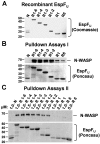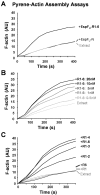Repetitive N-WASP-binding elements of the enterohemorrhagic Escherichia coli effector EspF(U) synergistically activate actin assembly
- PMID: 18974829
- PMCID: PMC2567903
- DOI: 10.1371/journal.ppat.1000191
Repetitive N-WASP-binding elements of the enterohemorrhagic Escherichia coli effector EspF(U) synergistically activate actin assembly
Abstract
Enterohemorrhagic Escherichia coli (EHEC) generate F-actin-rich adhesion pedestals by delivering effector proteins into mammalian cells. These effectors include the translocated receptor Tir, along with EspF(U), a protein that associates indirectly with Tir and contains multiple peptide repeats that stimulate actin polymerization. In vitro, the EspF(U) repeat region is capable of binding and activating recombinant derivatives of N-WASP, a host actin nucleation-promoting factor. In spite of the identification of these important bacterial and host factors, the underlying mechanisms of how EHEC so potently exploits the native actin assembly machinery have not been clearly defined. Here we show that Tir and EspF(U) are sufficient for actin pedestal formation in cultured cells. Experimental clustering of Tir-EspF(U) fusion proteins indicates that the central role of the cytoplasmic portion of Tir is to promote clustering of the repeat region of EspF(U). Whereas clustering of a single EspF(U) repeat is sufficient to bind N-WASP and generate pedestals on cultured cells, multi-repeat EspF(U) derivatives promote actin assembly more efficiently. Moreover, the EspF(U) repeats activate a protein complex containing N-WASP and the actin-binding protein WIP in a synergistic fashion in vitro, further suggesting that the repeats cooperate to stimulate actin polymerization in vivo. One explanation for repeat synergy is that simultaneous engagement of multiple N-WASP molecules can enhance its ability to interact with the actin nucleating Arp2/3 complex. These findings define the minimal set of bacterial effectors required for pedestal formation and the elements within those effectors that contribute to actin assembly via N-WASP-Arp2/3-mediated signaling pathways.
Conflict of interest statement
The authors have declared that no competing interests exist.
Figures








Similar articles
-
Enterohemorrhagic E. coli requires N-WASP for efficient type III translocation but not for EspFU-mediated actin pedestal formation.PLoS Pathog. 2010 Aug 19;6(8):e1001056. doi: 10.1371/journal.ppat.1001056. PLoS Pathog. 2010. PMID: 20808845 Free PMC article.
-
Membrane-deforming proteins play distinct roles in actin pedestal biogenesis by enterohemorrhagic Escherichia coli.J Biol Chem. 2012 Jun 8;287(24):20613-24. doi: 10.1074/jbc.M112.363473. Epub 2012 Apr 27. J Biol Chem. 2012. PMID: 22544751 Free PMC article.
-
Insulin receptor tyrosine kinase substrate links the E. coli O157:H7 actin assembly effectors Tir and EspF(U) during pedestal formation.Proc Natl Acad Sci U S A. 2009 Apr 21;106(16):6754-9. doi: 10.1073/pnas.0809131106. Epub 2009 Apr 6. Proc Natl Acad Sci U S A. 2009. PMID: 19366662 Free PMC article.
-
Attaching effacing Escherichia coli and paradigms of Tir-triggered actin polymerization: getting off the pedestal.Cell Microbiol. 2008 Mar;10(3):549-56. doi: 10.1111/j.1462-5822.2007.01103.x. Epub 2007 Dec 4. Cell Microbiol. 2008. PMID: 18053003 Review.
-
Cytoskeletal mechanisms regulating attaching/effacing bacteria interactions with host cells: It takes a village to build the pedestal.Bioessays. 2024 Nov;46(11):e2400160. doi: 10.1002/bies.202400160. Epub 2024 Sep 20. Bioessays. 2024. PMID: 39301984 Review.
Cited by
-
A teamwork promotion of formin-mediated actin nucleation by Bud6 and Aip5 in Saccharomyces cerevisiae.Mol Biol Cell. 2022 Feb 1;33(2):ar19. doi: 10.1091/mbc.E21-06-0285. Epub 2021 Nov 24. Mol Biol Cell. 2022. PMID: 34818061 Free PMC article.
-
Enteropathogenic E. coli relies on collaboration between the formin mDia1 and the Arp2/3 complex for actin pedestal biogenesis and maintenance.PLoS Pathog. 2018 Dec 14;14(12):e1007485. doi: 10.1371/journal.ppat.1007485. eCollection 2018 Dec. PLoS Pathog. 2018. PMID: 30550556 Free PMC article.
-
Regulation of podosome dynamics by WASp phosphorylation: implication in matrix degradation and chemotaxis in macrophages.J Cell Sci. 2009 Nov 1;122(Pt 21):3873-82. doi: 10.1242/jcs.051755. Epub 2009 Oct 6. J Cell Sci. 2009. PMID: 19808890 Free PMC article.
-
The EspF effector, a bacterial pathogen's Swiss army knife.Infect Immun. 2010 Nov;78(11):4445-53. doi: 10.1128/IAI.00635-10. Epub 2010 Aug 2. Infect Immun. 2010. PMID: 20679436 Free PMC article.
-
Wash functions downstream of Rho1 GTPase in a subset of Drosophila immune cell developmental migrations.Mol Biol Cell. 2015 May 1;26(9):1665-74. doi: 10.1091/mbc.E14-08-1266. Epub 2015 Mar 4. Mol Biol Cell. 2015. PMID: 25739458 Free PMC article.
References
Publication types
MeSH terms
Substances
Grants and funding
LinkOut - more resources
Full Text Sources
Molecular Biology Databases

